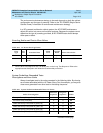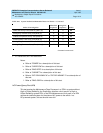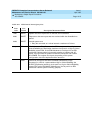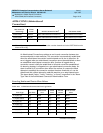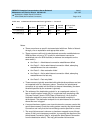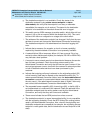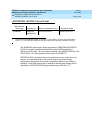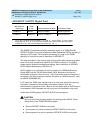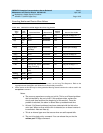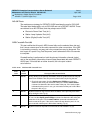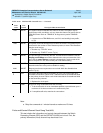
DEFINITY Enterprise Communications Server Release 5
Maintenance and Test for R5vs/si
555-230-123
Issue 1
April 1997
Maintenance Object Repair Procedures
Page 10-19ADM-CONN (Administered Connection)
10
g. The destination endpoint is not available. Check the status of the
destination endpoint (using status access-endpoint or status
data-module) and verify that the endpoint is not busy or otherwise
unavailable (for example, out-of-service). The status for the destination
endpoint is not available on the switch where this error is logged.
h. This switch sent an ISDN message to another switch, which either did not
respond (18) or did not respond within the allotted time (102). This could
be due to link failure or congestion or outage at the other switch.
i. The address of the destination endpoint has changed. Verify that the new
address is correct and change the Administered Connection accordingly.
The destination endpoint is not administered on the switch logging this
error.
j. Indicate that a resource (for example, a circuit or bearer capability)
required by the administered cConnection is not presently available.
k. A network failure (38) or temporary failure (41) has occurred. Error Log
entries for other maintenance objects (for example, DS1-BD or ISDN-LNK)
may indicate a local problem.
l. A request to use a network service has been denied because the service
has not been purchased. Check the routing pattern used by this
Administered Connection and verify that the service type is correct. If the
service type appears correct, check with the customer or network provider
or both to determine what services have been purchased by the
customer.
m. Indicate that outgoing calls may be barred on the originating switch (52)
or that incoming calls may be barred on the destination switch (54). To
restore an administered connection failure, issue the status administered
connection command for current administered connection state (observe
the retry count). If the administered connection state is "failed," then verify
and correct the Administered Connection Administration Form.
n. The requested bearer capability (65), channel type (66), or facility (69) is
not implemented or is unknown to the network. Check the address of the
destination endpoint and the routing pattern used by this Administered
Connection, and verify that they are correct and available.
o. These errors indicate that an ISDN protocol error has occurred.
p. The destination endpoint (or some intermediate facility) is not compatible
with the originating endpoint. Check the BCC fields of the routing pattern
used by this Administered Connection. Also, check if the originating and
destination endpoints are compatible (for example, the originating access
endpoint is voice-grade data, and the destination access endpoint is 64k
data).





